Mochi in 5 minutes? Yes, please! Daifuku mochi has to be our FAVOURITE Japanese snack of all time. Sweet sticky rice is wrapped around red bean paste to form soft as a pillow dessert bites you’ll want to make again and again.

Why We Love This
The sweet bean filling and chewy texture of daifuku mochi gets us every time. We would naughtily have these almost every day in Japan!
Being ready in 5 minutes and only needing 5 ingredients is a win for us. They make fantastic desserts to impress guests, especially if you need something last minute and have everything on hand.
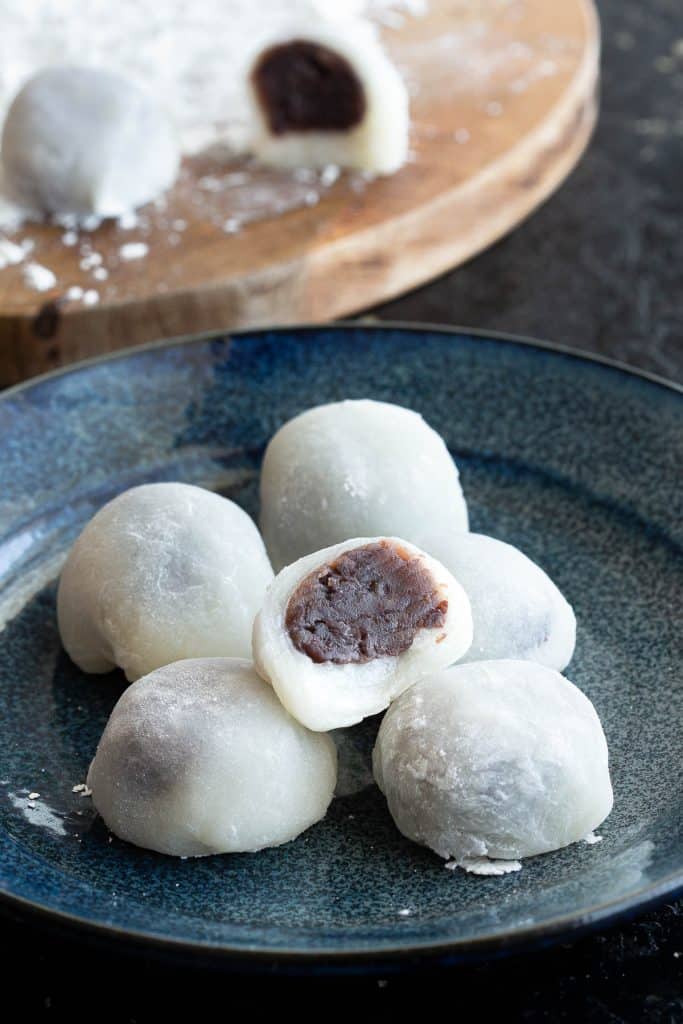
What is Mochi?
Mochi is a versatile little treat and we’ve found many types on our wanders across Japan. Sweet-tooths especially will fall in love with the sweet red bean filled version we’ve made today – known as daifuku mochi. We’ve also seen them coated in matcha (green tea) powder, kinako (toasted soy bean) powder, or mixed with yomogi (mugwort) herb.
Plain mochi can be enjoyed as is, but for something devilishly good, coat it in butter and gently fry in a pan on both sides for a few minutes. Add a pinch of salt over the top and serve hot – we guarantee there will be no turning back after this. It somehow tastes like buttered popcorn with a crunchy exterior and soft chewy centre. Yum yum!
Where We Discovered this Sweet Treat
Along a footpath in Kagoshima, Japan Outside we saw an old mochi pestle (usu) pushed up against the wall of the shop. We paused to take a few quick photos, thinking it might just be a decorative piece, then slowly became aware of the crowd gathering around us.
The crowd parted to make way for an old man with a steaming tray of sticky rice as we stepped back to watch. He handed it to two young men holding massive wooden kine mallets. They threw the rice into the wooden usu mill and got to work, pounding the rice into a glutinous paste amongst a multitude of grunts and shouts. Next they slammed it, still steaming, onto a tray and whisked it inside to be moulded into delicious mochi. The Mochitsuki had begun!
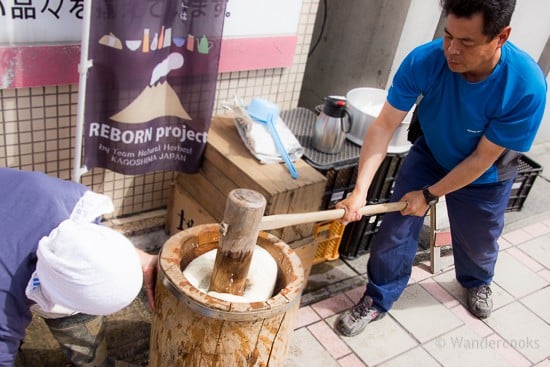
While the recipe for mochi is quite simple, just cooked sticky rice and lots of water, it quickly became apparent that preparing it the traditional way takes a lot of effort. The guys operating the usu worked in tandem with the ease of long years of practice. While one used the heavy wooden kine to pound the rice, the other added water and rotated the thickening mixture, as it gradually transformed from individual grains into a sticky, glutinous ball.
We’re glad to be able to recreate daifuku mochi at home in just 5 minutes, but if you ever get the opportunity to make it from scratch with a hammer and all – we thoroughly recommend it.
What You’ll Need
Never has a Japanese dessert been so easy to recreate at home! You need 5 ingredients and at least 3 should already be in your kitchen – sugar, water and cornstarch (or potato/tapioca starch) for coating. The next two ingredients are what will make or break this recipe – glutinous rice flour (aka sticky rice flour) and red bean paste (known as anko in Japanese).
- Glutinous Rice Flour – Traditionally, if you can find Japanese sweet rice flour known as Shiratamako or Mochiko, this would be best. However, the easiest substitute is regular glutinous rice flour. We’ve found it at our local and Asian supermarkets as well as online. Look out for the see-through bag with the green writing – not the red writing (which is regular rice flour and not sticky!).
- Red Bean Paste – We use homemade coarse red bean paste (also known as anko) from boiling and mashing azuki beans with sugar, but you can use the fine bean paste as well, it’s completely up to your taste. Store bought is fine – you’ll find it at your local Asian supermarket. In a pinch, you could make a filling with sweetened kidney beans, like in Vietnamese 3 Colour Bean Dessert. Or ditch the beans, and make up your own filling!
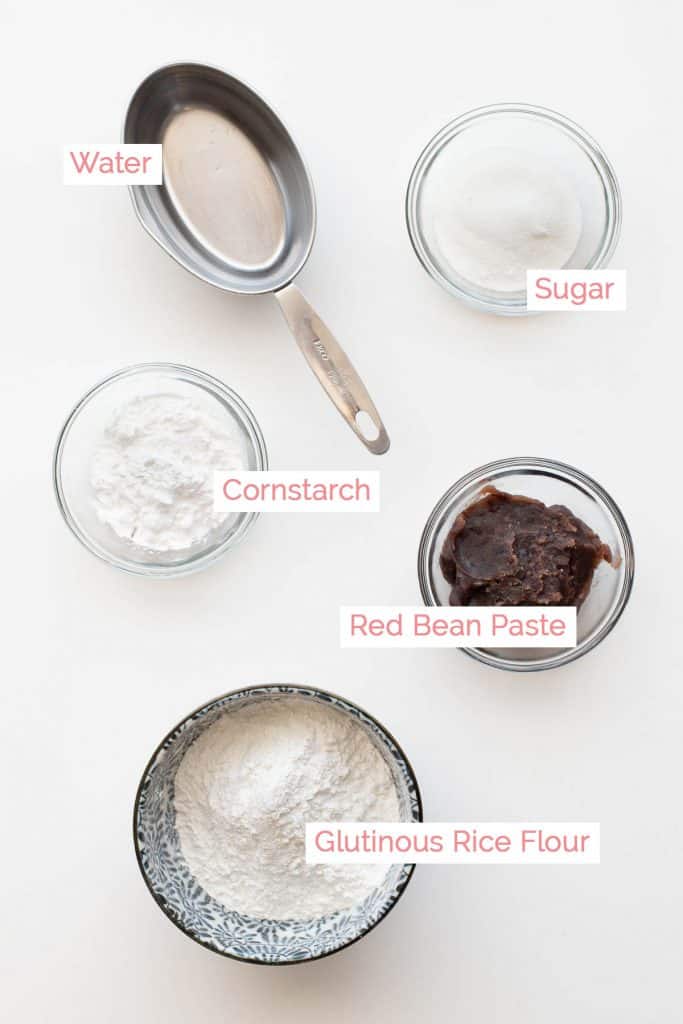
How to make:
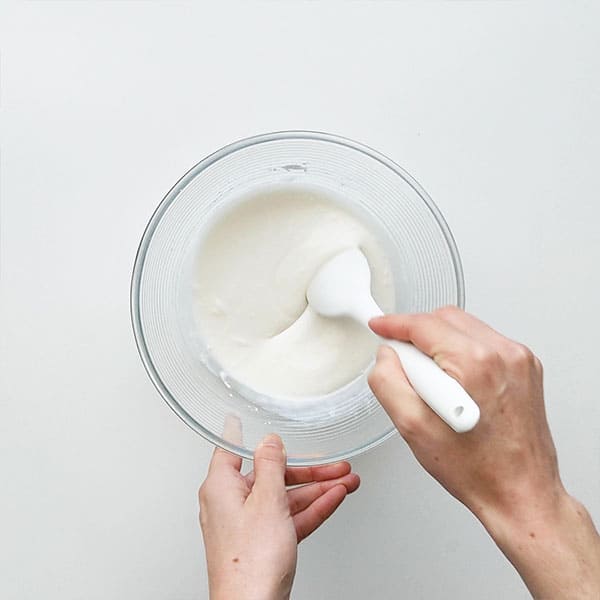
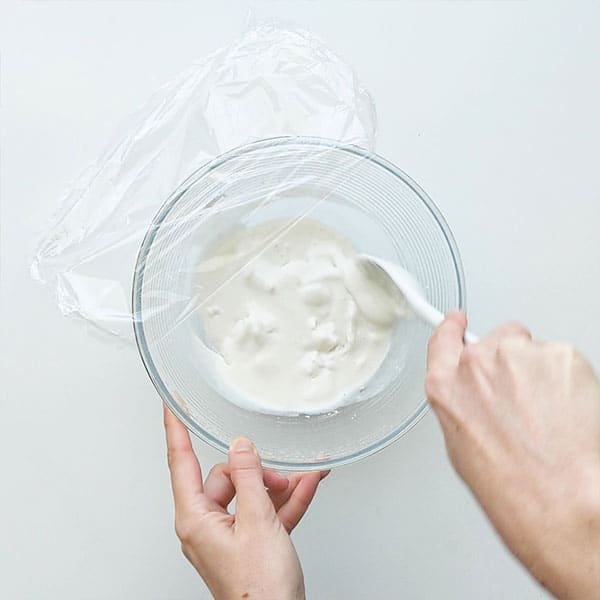
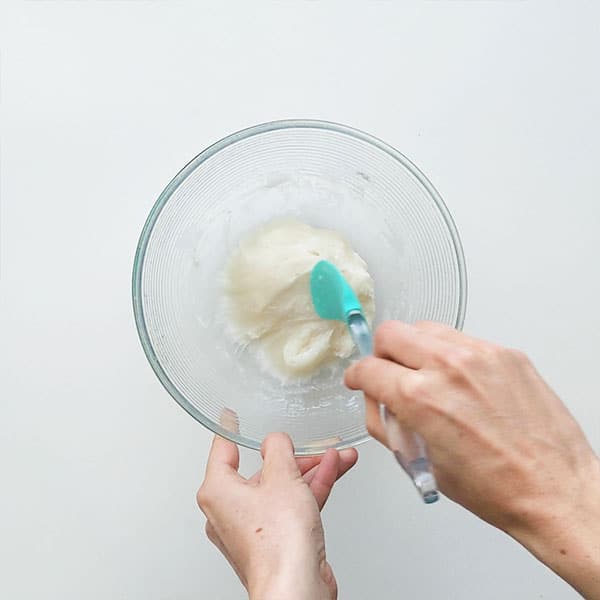
- In a large bowl, mix together the 1 heaped cup of glutinous rice flour, 4 tbsp of sugar and 1/2 cup of water until combined.
- Loosely cover with cling wrap and microwave for 1 minute. With the spoon, give it a quick mix, re-cover and pop back in for another minute.
- Get a spatula, and wet it in water. Pull the mochi away from the sides and fold it in until it’s a rough dough ball shape. It should be sticky and pliable, with the colour turning from bright white to a more translucent cream.
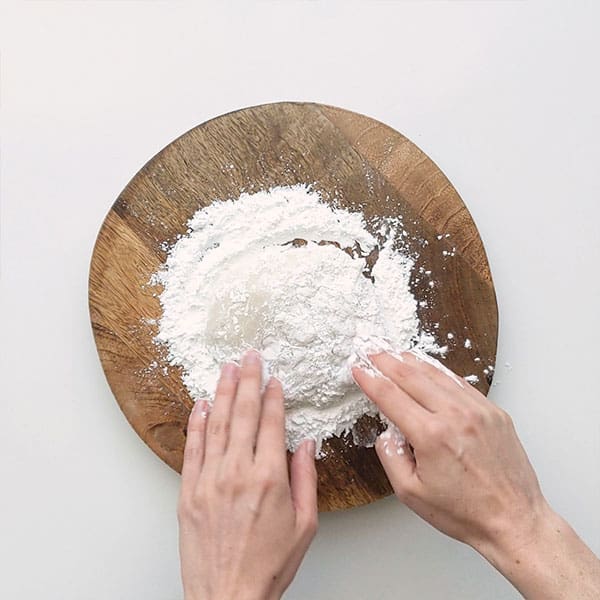
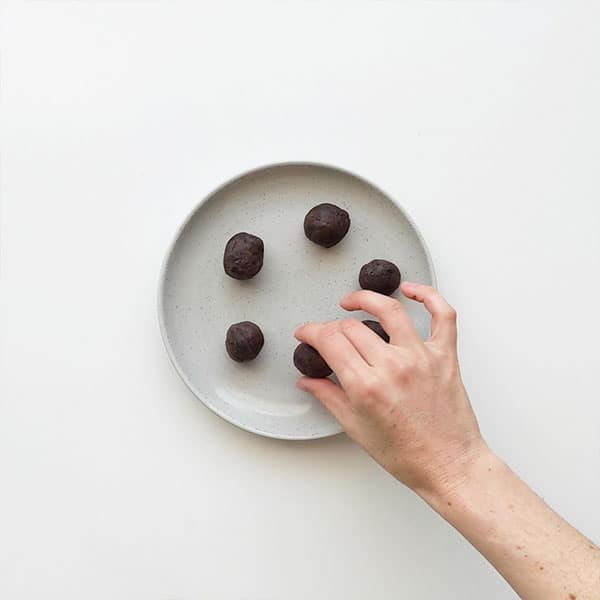
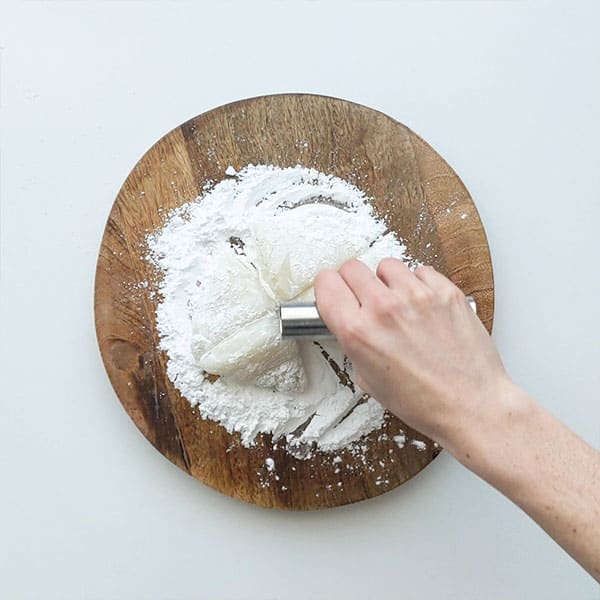
- Spread the cornstarch on a clean dry surface, and pop the mochi onto it using the wet spatula. Cover it with cornstarch until it’s no longer sticky, molding it into a thick and flat disc, and allow to cool for a few minutes.
- Roll 1 tbsp of red bean paste into a ball, and repeat until you have 8 balls ready to wrap with mochi.
- Grab the cooled mochi dough and cut into 8 even pieces using a knife or dough cutter (pop a bit of cornstarch on to avoid sticking).
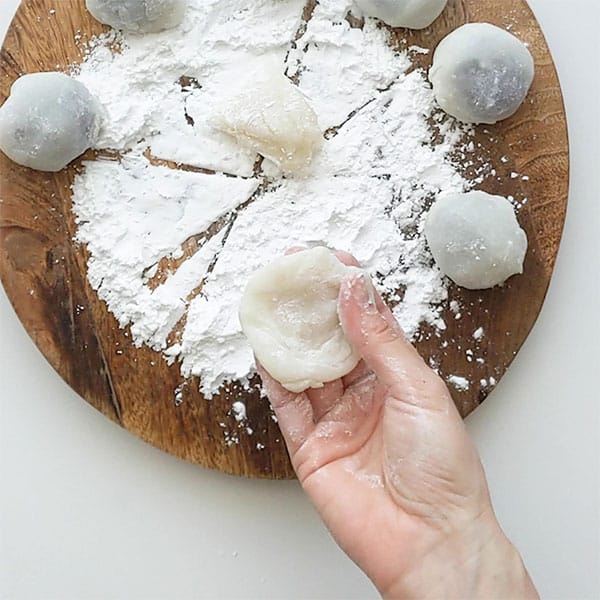
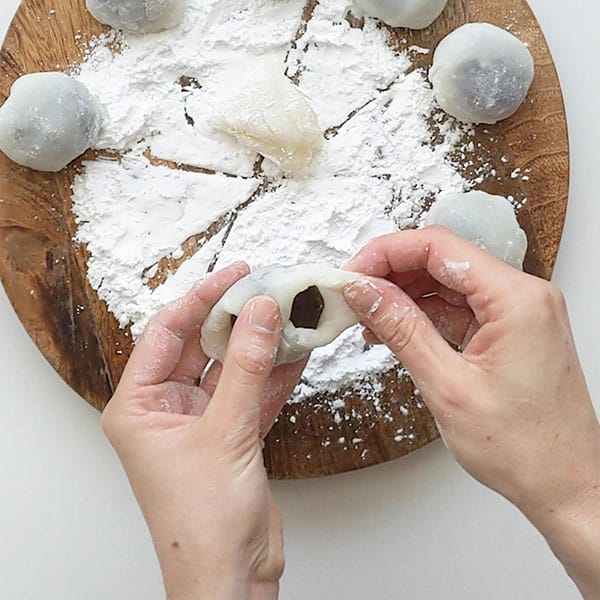
- Coat your fingertips in the cornstarch and pick up your first piece of mochi. Flatten and shape into a disc around 10cm / 2 inches wide.
- Place a red bean paste ball into the centre and wrap the mochi dough around it. Pull up the edges into the centre and pinch it altogether.
- Place the mochi seam side down and repeat with the remaining dough and bean paste. Serve immediately, and best eaten within the day.
Wandercook’s Tips
- While cooking, look for the change of colour. You want the bright white to fade to a more translucent cream colour.
- If it’s sticking while trying to form the mochi, add a little more cornstarch.
- You can roll out the mochi if you prefer, rather than stretching it by hand.
- The mochi itself is super stretchy, so don’t be afraid when pulling it over the red bean paste filling.
- Serve as a dessert after classic Japanese dishes like okonomiyaki and yakisoba noodles, or alongside green tea ice cream!
FAQs
Best enjoyed within 24 hours. If you can, leave it out of the fridge for the freshest taste. If you really can’t eat them all, they will keep overnight in a zip-lock plastic bag in the fridge OR you can freeze them. If freezing, coat in a little extra corn starch so they don’t stick together and pop them in a zip-lock plastic bag. Eat within the month if freezing for the best taste. To thaw, you can either leave them out on the bench for an hour or so, or heat them in 10 second bursts until thawed.
While daifuku mochi is super popular, there are so many other filling options for mochi itself. Get creative and put whatever you like inside.
– Ice-cream filled mochi takes your dessert to a whole other level. Try vanilla, green tea, strawberry or black sesame!
– Sweet mung bean paste – like in Che Ba Mau
– Strawberries covered in red bean paste
– Fresh cream
– Speculoos cookie butter
– Chocolate mousse
– Peanut butter & banana
Unfortunately no. It’s the sticky aspect of glutinous or sweet rice powder that gives mochi it’s iconic texture and helps it bind together into the perfect pliable dough. You should be able to find glutinous rice flour at your local Asian supermarket or online.
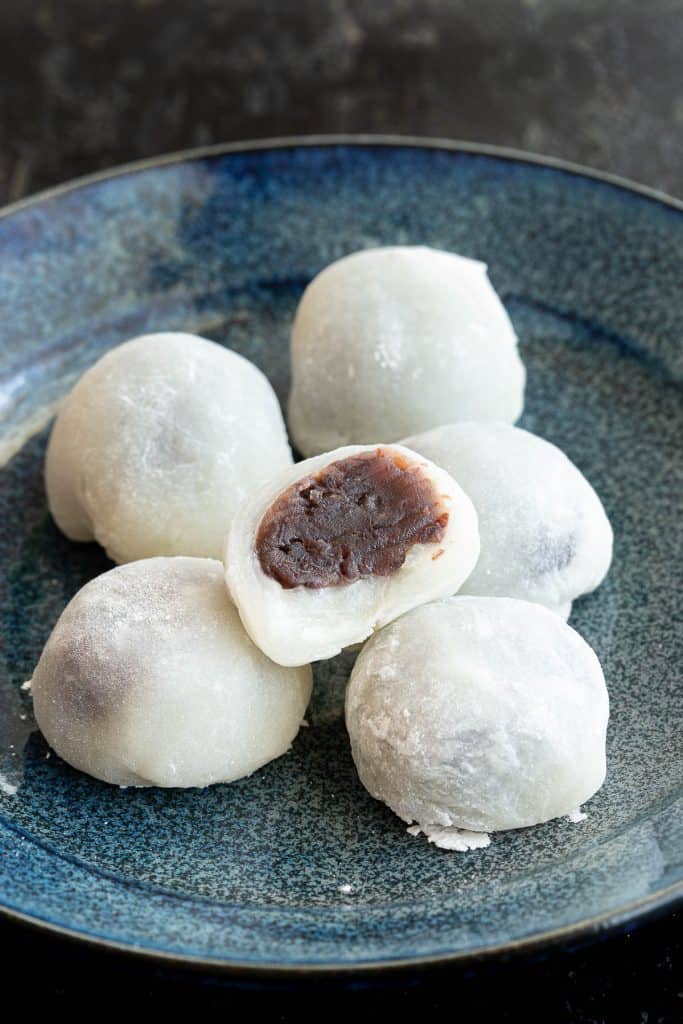
Want more treats? These are some of our favourites:
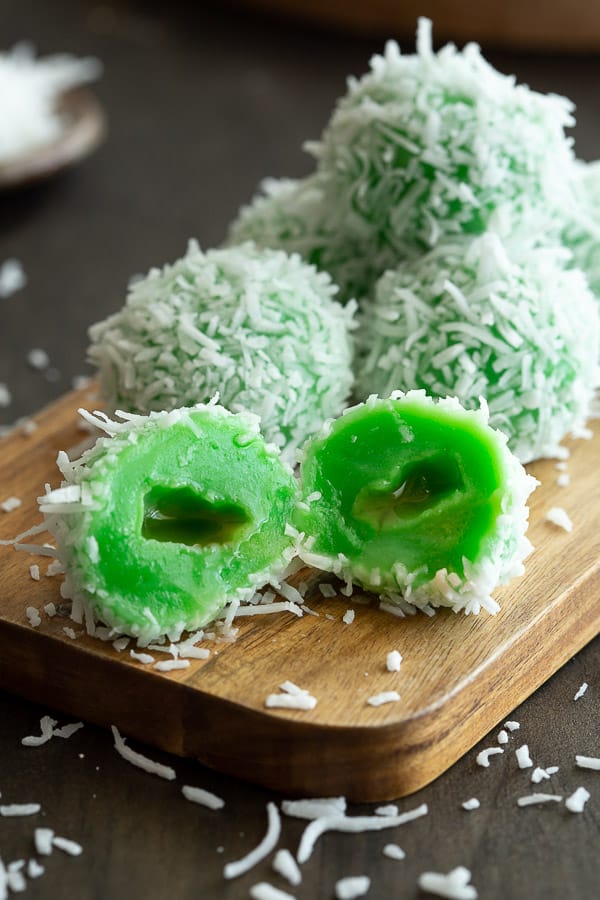
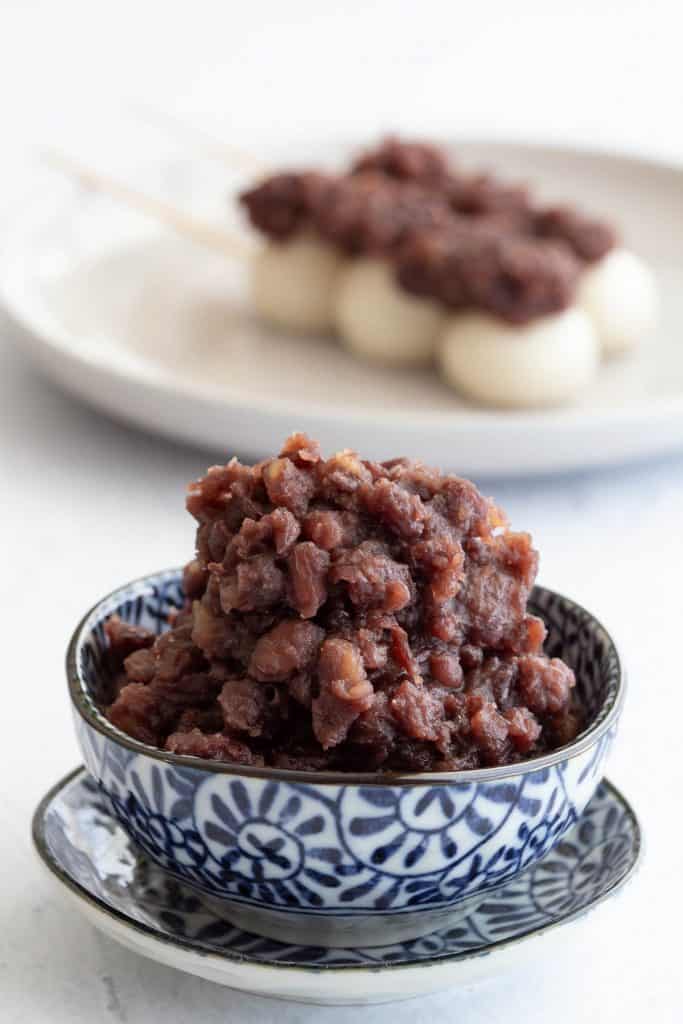
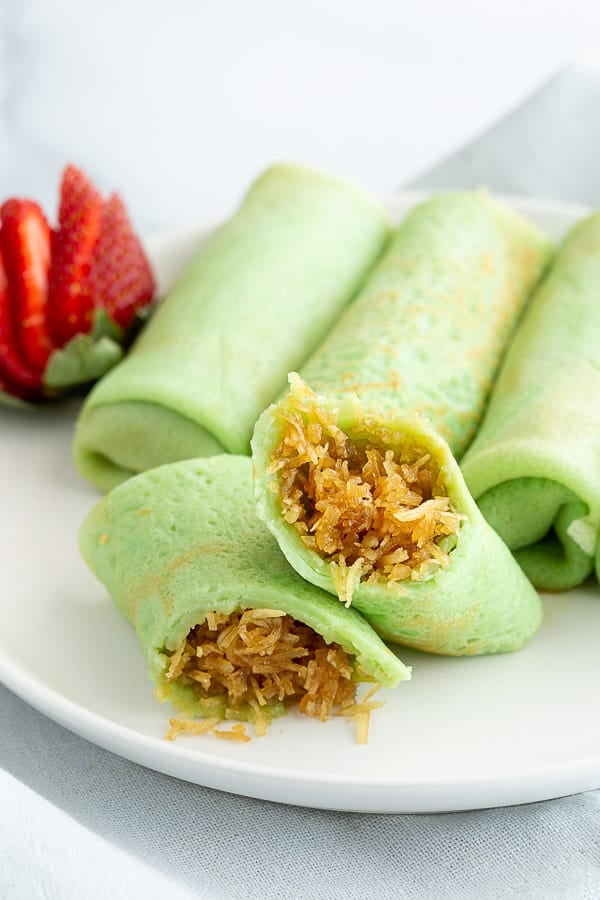
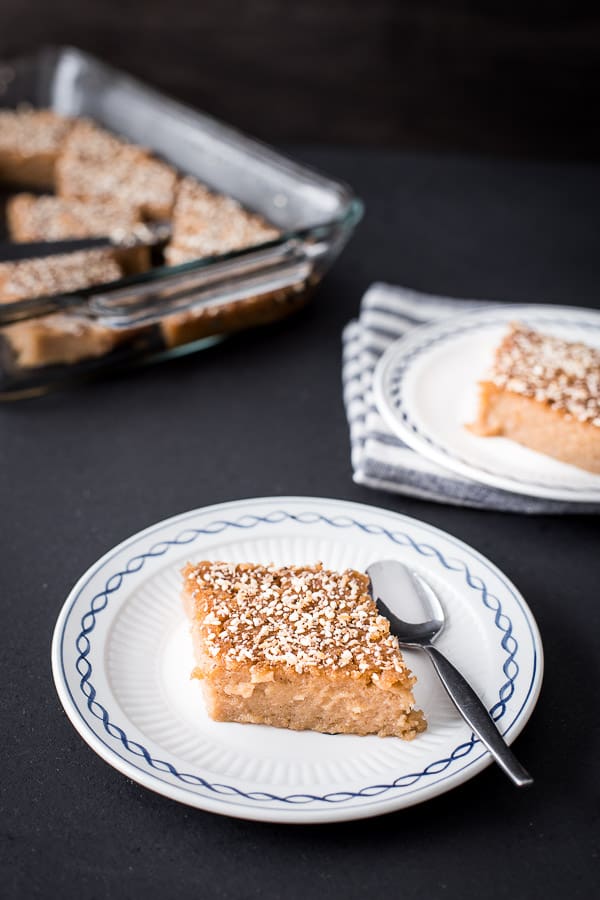
★ Did you make this recipe? Please leave a comment and star rating below!
Ingredients
- 115 g glutinous rice flour (1 heaped cup)
- 60 g sugar (4 tbsp)
- 125 ml water (½ cup)
- 8 tbsp red bean paste
- 1 tbsp cornstarch / cornflour to cover surface
Instructions
- In a large bowl, mix together the glutinous rice flour, sugar and water until combined.115 g glutinous rice flour, 60 g sugar, 125 ml water
- Loosely cover with cling wrap and microwave for 1 minute.
- With the spoon, give it a quick mix, re-cover and pop back in for another minute.
- Get a spatula, and wet it in water. Pull the mochi away from the sides and fold it in until it's a rough dough ball shape. It should be sticky and pliable, with the colour turning from bright white to a more translucent cream.
- Spread the cornstarch on a clean dry surface, and pop the mochi onto it using the wet spatula. Cover it with cornstarch until it's no longer sticky, molding it into a thick and flat disc, and allow to cool for a few minutes.1 tbsp cornstarch / cornflour
- Roll 1 tbsp of red bean paste into a ball, and repeat until you have 8 balls ready to wrap with mochi.8 tbsp red bean paste
- Grab the cooled mochi dough and cut into 8 even pieces using a knife or dough cutter (pop a bit of cornstarch on to avoid sticking).
- Coat your fingertips in the cornstarch and pick up your first piece of mochi. Flatten and shape into a disc around 10cm / 2 inches wide. Place a red bean paste ball into the centre and wrap the mochi dough around it. Pull up the edges into the centre and pinch it altogether.
- Place the mochi seam side down and repeat with the remaining dough and bean paste. Serve immediately, and best eaten within the day.
Video
Recipe Notes
- Filling Ideas:
- Ice-cream filled mochi takes your dessert to a whole other level. Try vanilla, green tea, strawberry or black sesame!
- Sweet mung bean paste – like in Che Ba Mau
- Strawberries covered in red bean paste
- Fresh cream
- Speculoos cookie butter
- Chocolate mousse
- Peanut butter & banana
- Glutinous Rice Flour – Traditionally, if you can find Japanese sweet rice flour known as Shiratamako or Mochiko, this would be best. However, the easiest substitute is regular glutinous rice flour. We’ve found it at our local and Asian supermarkets as well as online. Look out for the see-through bag with the green writing – not the red writing (which is regular rice flour and not sticky!). Unfortunately can not substitute with all purpose flour or regular rice flour.
- Red Bean Paste – We used coarse red bean paste, but you can use the fine bean paste as well, it’s completely up to your taste. Store bought is fine – you’ll find it at your local Asian supermarket, otherwise you can also make your own from azuki beans. In a pinch, you could make a filling with sweetened kidney beans, like in Vietnamese 3 Colour Bean Dessert. Or ditch the beans, and make up your own filling!
- While cooking, look for the change of colour. You want the bright white to fade to a more translucent cream colour.
- If it’s sticking, while trying to form the mochi, add a little more cornstarch.
- Storage: Best enjoyed within 24 hours. If you can, leave it out of the fridge for the freshest taste. If you really can’t eat them all, they will keep overnight in a zip-lock plastic bag in the fridge OR you can freeze them. If freezing, coat in a little extra corn starch so they don’t stick together and pop them in a zip-lock plastic bag. Eat within the month if freezing for the best taste. To thaw, you can either leave them out on the bench for an hour or so, or heat them in 10 second bursts until thawed.
Nutrition
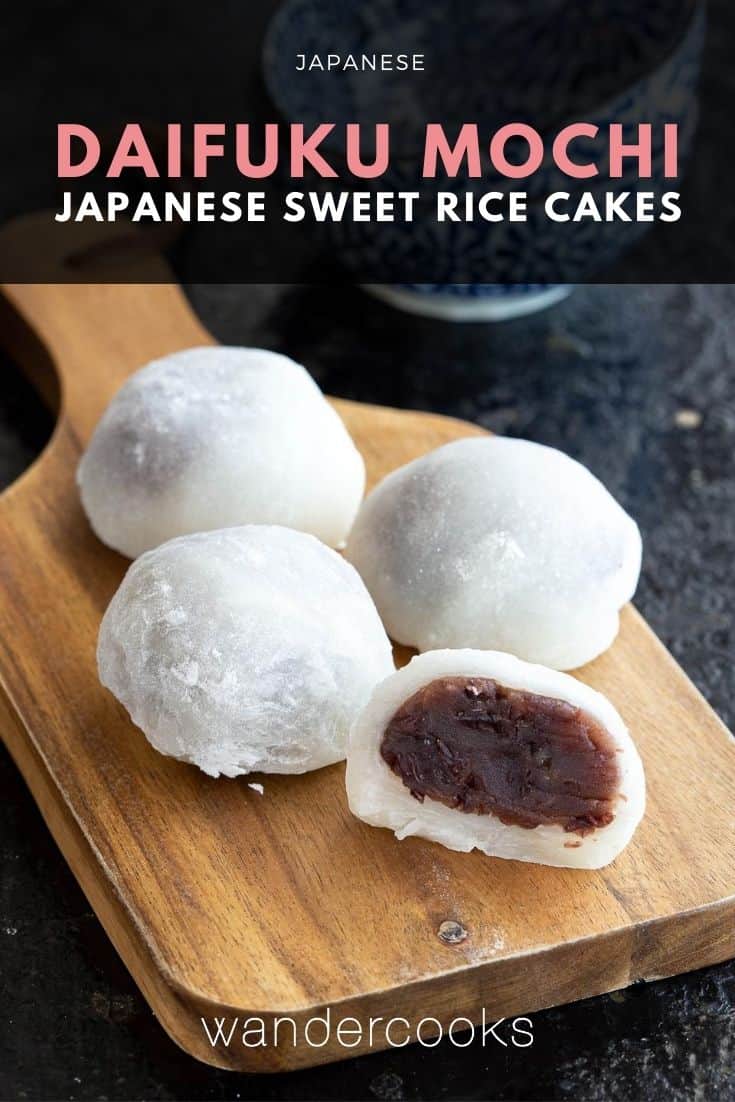

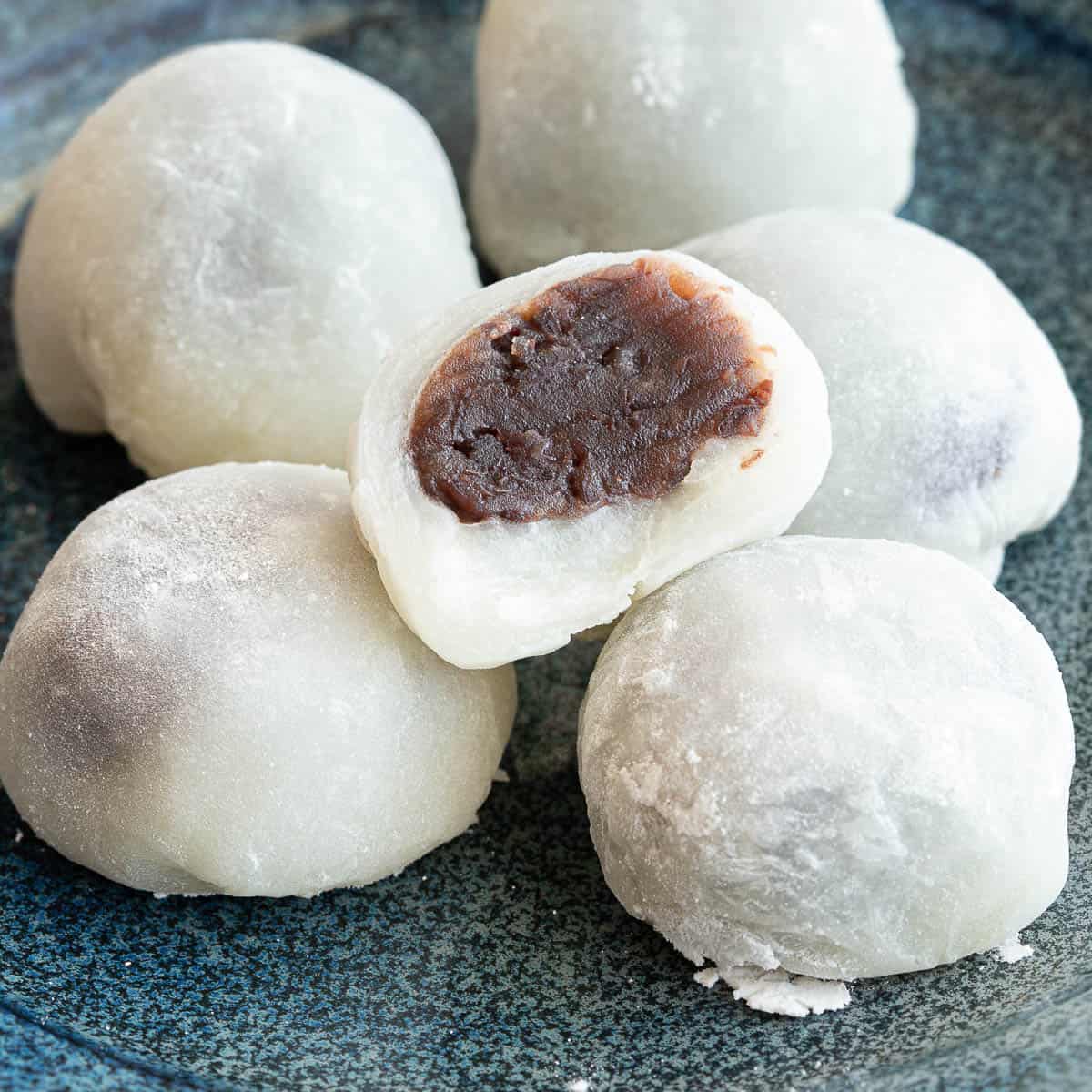


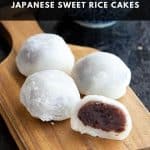
2 Comments
maze
02/08/2023 at 5:49 pmHello, I love the recipe, but as I excitedly got to reading, thinking I finally found an easy how-to for mochi… I realised that it is completely useless to me due to lack of a microwave. Would it be possible to get pointers on how to get around that small technical snag? I know it’s not common in the US to not own one, but I’ve known plenty enough microwave-less people (especially outside of the US: chances of a microwave being in a house in a lot of places in Europe for instance are about 50:50) to think it might be good idea to include alternate ways of getting around the use of one in recipes, if possible. Thank you in advance!
Wandercooks
22/08/2023 at 10:03 amHeya, great question. We haven’t found an easy version without a microwave yet – however, you could definitely try the more traditional method making it from cooked rice and a stand mixer if you have one using Just One Cookbook’s recipe. 🙂